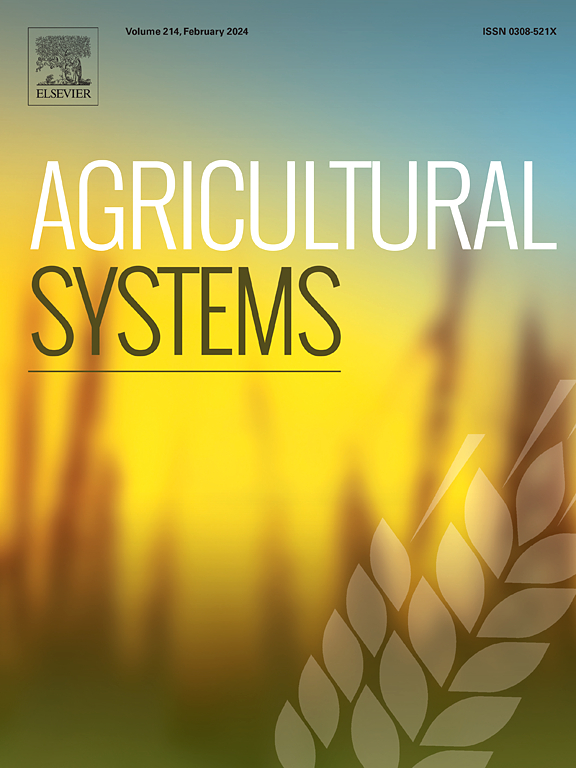Family farming stands out for its environmental performance in Uruguay's agricultural sector
IF 6.1
1区 农林科学
Q1 AGRICULTURE, MULTIDISCIPLINARY
引用次数: 0
Abstract
Context
The environmental performance of family farming is strikingly under-documented, despite its recognized strategic importance within agri-food systems. Determining whether family farming has a distinct environmental footprint or not can provide valuable insights into its potential role in agricultural sustainability.
Objective
We evaluated the environmental performance of family and non-family farms across different production systems and geomorphological regions in Uruguay.
Methods
Five locally validated synoptic indicators were assessed to describe aspects related to biodiversity, the supply of various Ecosystem Services (ES) and resilience to habitat loss: the proportion of natural habitats (i.e., natural grasslands and forests), the supply of supporting and regulating ES and its temporal trend, soil conservation and the functional diversity of non-natural habitats. We also calculated a synthetic environmental performance index to reflect overall environmental status across multiple indicators.
Results and conclusions
Amidst wide variability, family farms outperformed non-family farms across most indicators, regions, and production systems. Family farming likely fosters virtuous multifunctional landscapes, as our findings suggest that it maintains more natural habitats, supports greater functional diversity, and ensures a higher supply of ES. Family farms also demonstrated greater resilience to disturbances, such as the transformation of natural habitats, compared to non-family farms.
Significance
This study integrates nationwide, spatially-detailed remote-sensing indicators within a quantitative, multidimensional framework, providing unprecedented insight into the noteworthy environmental performance of family farming in Uruguay. These findings can guide research into the mechanisms driving this pattern and inform policies to bolster family farming at scales from local communities to regional and national jurisdictions in Uruguay and comparable agricultural contexts.

家庭农业在乌拉圭农业部门的环境表现突出
尽管家庭农业在农业粮食系统中具有公认的战略重要性,但对其环境绩效的记录却明显不足。确定家庭农业是否具有独特的环境足迹可以为其在农业可持续性方面的潜在作用提供有价值的见解。目的:我们评估了乌拉圭不同生产系统和地貌区域的家庭和非家庭农场的环境绩效。方法利用自然生境(即天然草地和森林)的比例、支持和调节生态系统的供应及其时间趋势、土壤保持和非自然生境的功能多样性等5个经当地验证的天气学指标来描述与生物多样性、各种生态系统服务(ES)的供应和对栖息地丧失的恢复力相关的方面。我们还计算了一个综合环境绩效指数,以反映多个指标的整体环境状况。结果和结论:在广泛的变异性中,家庭农场在大多数指标、地区和生产系统上的表现优于非家庭农场。我们的研究结果表明,家庭农业可能会促进良性的多功能景观,因为它保持了更多的自然栖息地,支持了更大的功能多样性,并确保了更高的ES供应。与非家庭农场相比,家庭农场还表现出更强的抗干扰能力,如自然栖息地的改变。本研究将全国范围的、空间详细的遥感指标整合到一个定量的、多维的框架中,为乌拉圭家庭农业显著的环境绩效提供了前所未有的见解。这些发现可以指导对推动这种模式的机制的研究,并为政策提供信息,以支持乌拉圭和类似农业背景下从地方社区到区域和国家管辖区的大规模家庭农业。
本文章由计算机程序翻译,如有差异,请以英文原文为准。
求助全文
约1分钟内获得全文
求助全文
来源期刊

Agricultural Systems
农林科学-农业综合
CiteScore
13.30
自引率
7.60%
发文量
174
审稿时长
30 days
期刊介绍:
Agricultural Systems is an international journal that deals with interactions - among the components of agricultural systems, among hierarchical levels of agricultural systems, between agricultural and other land use systems, and between agricultural systems and their natural, social and economic environments.
The scope includes the development and application of systems analysis methodologies in the following areas:
Systems approaches in the sustainable intensification of agriculture; pathways for sustainable intensification; crop-livestock integration; farm-level resource allocation; quantification of benefits and trade-offs at farm to landscape levels; integrative, participatory and dynamic modelling approaches for qualitative and quantitative assessments of agricultural systems and decision making;
The interactions between agricultural and non-agricultural landscapes; the multiple services of agricultural systems; food security and the environment;
Global change and adaptation science; transformational adaptations as driven by changes in climate, policy, values and attitudes influencing the design of farming systems;
Development and application of farming systems design tools and methods for impact, scenario and case study analysis; managing the complexities of dynamic agricultural systems; innovation systems and multi stakeholder arrangements that support or promote change and (or) inform policy decisions.
 求助内容:
求助内容: 应助结果提醒方式:
应助结果提醒方式:


